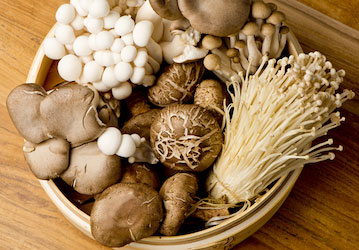Mushrooms have been a popular food savored for its tasty, meaty flavor and medicinal properties for thousands of years. Although technically a type of fungus, there are over 2,000 edible varieties of mushrooms used in various ethnic cuisines. There’s also growing interest in mushrooms both as a food and as an ingredient in various food products and dietary supplements. Mushrooms can be a nutrient-rich addition to a balanced eating plan!
Nutrients and health benefits
Mushrooms contain a wide variety of vitamins, minerals, and other beneficial nutrients.
- Riboflavin (vitamin B2)
- Niacin (vitamin B3)
- Pantothenic acid (a B vitamin)
- Vitamin D in mushrooms exposed to ultraviolet light
- Copper
- Phosphorus
- Selenium
- Fiber
- Prebiotics
- Flavanoids that act as antioxidants
Many of the nutrients in mushrooms have been linked to positive health outcomes and lower risk of death. Mushrooms show promise as support for healthy immune function, gut health, and blood sugar levels, and might offer anti-cancer benefits too. Mushrooms are also low in calories, which can be helpful for weight control and weight loss.
Mushrooms can be a nutrient-rich addition to a balanced eating plan! When you’re at the store, look for ones with an even texture and whole, firm caps.
A word of caution
Due to their nutrient density and historic use as medicine, mushrooms are added as an ingredient to coffee, tea, other food products, and dietary supplements. Although products that contain powdered mushroom or extracts might sound appealing, there’s no evidence to suggest they’re safe or effective other than as a food. For more information on mushrooms in dietary supplements, see the OPSS article.
In addition, some varieties of mushrooms are toxic and should be avoided in any form. Your safest bet is to stick with the mushrooms you buy at your local grocery store.
Mushrooms on your plate
Versatile and nutritious, mushrooms offer a flavorful and nutrient-dense addition to your performance-nutrition menu. You can choose any of the common varieties of edible mushrooms, such as portobello, enoki, shiitake, or button. There are many ways you can enjoy mushrooms for both their “umami” (or meaty) taste and nutritional benefits.
- Sauté with other vegetables as part of a stir-fry.
- Add raw to salads or sandwiches.
- Blend chopped mushrooms with ground meat or use as a meat substitute.
- Roast in the oven.
- Add to casseroles, pasta dishes, and pizza.
- Grill mushroom caps on skewers or as a burger.
- Add to omelets, scrambled eggs, and other egg dishes.
When you’re at the store, look for mushrooms that have an even texture and whole, firm caps. You can store them in your refrigerator (in the original package) or a brown paper bag for up to one week. Before preparing, brush off any dirt with your finger, give them a gentle rinse, and pat dry with a paper towel. Frozen, canned, or dried varieties are also good options.
